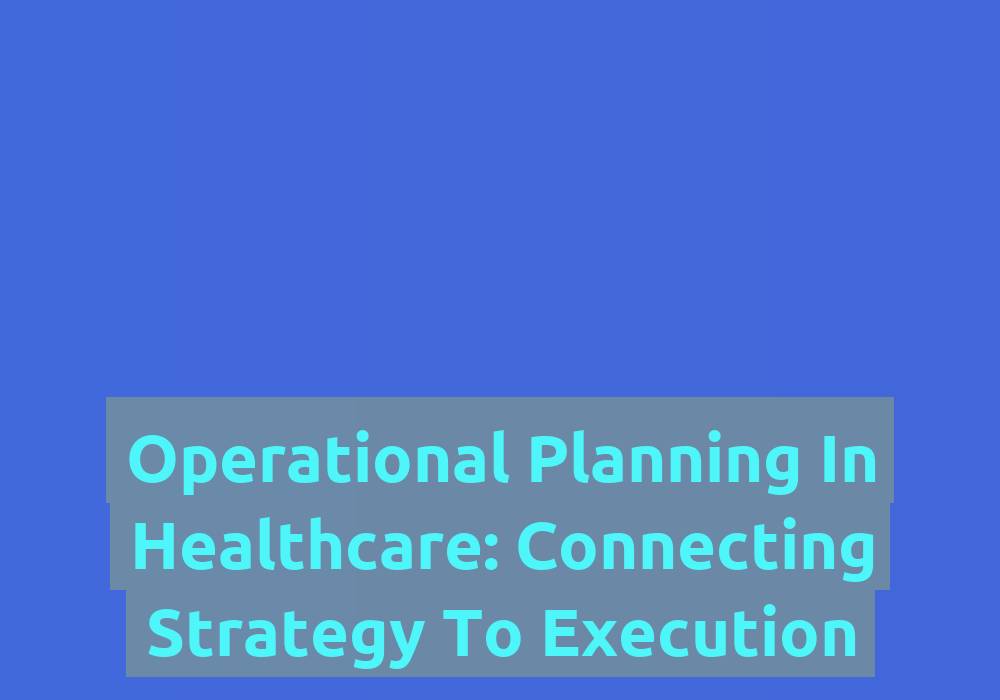Starting a Healthcare Delivery Service: A Complete Guide
Conducting Comprehensive Research and Strategic Planning
In-Depth Market Analysis for Healthcare Services

A thorough understanding of the healthcare delivery market is essential for anyone contemplating how to start a healthcare delivery service. This process involves a detailed analysis of both demand and competition. Start by identifying the specific services your target demographic is seeking. For instance, there is a growing demand for elderly care services and mental health support as a result of the increasing ageing population and greater awareness of mental health issues across the UK. Recognising these trends can position your service advantageously in the market.
Additionally, take the time to evaluate the competitive landscape. Who are the major players operating in your geographical area? What range of services do they offer, and at what pricing structures? Conducting a comprehensive analysis of your competitors will help you uncover gaps in the market that your service could successfully fill. Employing tools such as SWOT analysis (Strengths, Weaknesses, Opportunities, Threats) can provide valuable insights into your position relative to your competitors. Furthermore, local healthcare statistics and demographic information can be sourced from the Office for National Statistics (ONS) and local health authorities, offering a solid framework for your market analysis.
Moreover, actively engage with potential clients through targeted surveys or focus groups to gather qualitative data. This direct feedback mechanism will allow you to refine your service offerings, ensuring they are closely aligned with customer expectations and needs. Ultimately, a comprehensive market analysis not only informs your business model but also fortifies your enterprise’s position within the competitive healthcare landscape.
Developing a Comprehensive Business Plan
Creating a robust business plan is a fundamental step in the journey of how to start a healthcare delivery service. Your business plan should clearly define your service model, detailing your approach to providing healthcare services—be it in-home care, telehealth, or mobile clinics. Additionally, it is crucial to outline your financial projections comprehensively, including start-up costs, operational expenses, and realistic revenue forecasts. Adopting a conservative approach in your estimates will help ensure long-term sustainability.
Consider incorporating clear growth strategies within your business plan. How do you envision scaling your services in the future? This could involve broadening your service area, introducing new services, or forming strategic partnerships with local healthcare providers. Furthermore, a well-developed marketing strategy embedded within your business plan can distinguish you from your competitors. Detail how you intend to communicate your services to prospective clients, utilising both online and offline marketing techniques that resonate with your target audience.
Additionally, seek guidance from seasoned professionals or mentors within the healthcare sector while crafting your business plan. Their insights can prove invaluable and may help you navigate common pitfalls. A well-structured business plan serves not only as a roadmap for your venture but also as a critical tool when seeking funding or partnerships in the future.
Navigating Regulatory Requirements in Healthcare Delivery
Understanding the regulatory landscape is a vital component of how to start a healthcare delivery service. The UK is governed by strict regulations concerning healthcare services, primarily enforced by regulatory bodies such as the Care Quality Commission (CQC). It is essential to familiarise yourself with the various regulatory requirements applicable to your specific type of service. This includes understanding care standards, staff qualifications, and patient safety laws that must be adhered to.
You will need to apply for the necessary registrations and certifications to operate legally. For example, if your service includes medical offerings, registering with the General Medical Council (GMC) may be obligatory. Furthermore, compliance with data protection regulations, particularly the General Data Protection Regulation (GDPR), is critical as healthcare services handle sensitive personal data.
Regular training and updates on compliance for your staff will help uphold adherence to these regulations. Proactively understanding and implementing regulatory requirements not only shields your business from potential legal repercussions but also cultivates trust with your clients, ensuring they feel safe and secure in your care.
Establishing Legal Structure and Registration for Your Healthcare Service

Selecting the Right Business Structure
Choosing the appropriate legal structure is a pivotal decision in how to start a healthcare delivery service. The structure you opt for—whether it be a sole trader, partnership, or limited company—will have implications for your liability, tax obligations, and administrative responsibilities. For many healthcare enterprises, establishing a limited company is advisable as it offers limited liability protection, safeguarding your personal assets in the event of business debts or legal issues.
Consulting with a solicitor or an accountant who is well-versed in healthcare regulations can provide clarity on which structure aligns best with your business model. They can also assist you in navigating any potential tax implications associated with each structure. Furthermore, understanding the ramifications of each option allows you to plan for future growth. For instance, if you anticipate expanding your operations and attracting investors or shareholders, a limited company structure may provide greater flexibility.
Moreover, consider how your selected structure aligns with your long-term goals. If you foresee scaling your operations or attracting investors, establishing a limited company from the outset could facilitate these ambitions. In essence, the right legal structure not only protects your assets but also positions your healthcare delivery service for sustainable growth.
Completing Your Registration with Companies House
Once you have determined your business structure, the subsequent step in how to start a healthcare delivery service is registering your business with Companies House. This process formally establishes your business as a legal entity and is crucial for compliance with UK law. You will need to prepare specific documentation, including your company name, registered address, and details pertaining to your directors.
The registration process is typically straightforward and can be completed online, providing an efficient way to formalise your business. It is essential to ensure that your company name is unique and complies with UK regulations. Upon successful registration, you will receive a Certificate of Incorporation, which is necessary for opening a business bank account and applying for business loans.
Being officially listed with Companies House also enhances your credibility with potential clients and investors, indicating compliance with legal requirements. Maintaining your registration by regularly filing annual accounts is critical for ongoing compliance and operational integrity. This foundational step sets the stage for your healthcare delivery service to excel in a competitive market.
Securing Necessary Licences for Operation

Acquiring the appropriate licences is a critical milestone in how to start a healthcare delivery service. Depending on the services you intend to provide, you may need specific healthcare licences and permits. Initiate this process by identifying all regulatory bodies relevant to your services. For example, if you are delivering personal care services, registration with the Care Quality Commission (CQC) is mandatory, ensuring that you meet the required standards of care.
The application process for licensing can be intricate, often necessitating detailed documentation, including proof of compliance with health and safety standards, evidence of staff qualifications, and comprehensive operational procedures. Attention to detail in your application can expedite the approval process. It may also be beneficial to consult with professionals experienced in the licensing process to ensure that all necessary aspects are covered.
Additionally, remain vigilant about any changes in regulations that could affect your licensing requirements. Regular training and updates for your team can help maintain compliance with licensing conditions and build a culture of continuous improvement. Securing the necessary licences not only legitimises your services but also instils confidence in your clients, assuring them of the quality of care they can expect to receive.
Ensuring Tax Registration Compliance
Ensuring compliance with tax registration is paramount in how to start a healthcare delivery service. Your healthcare business will need to register for Value Added Tax (VAT) and Pay As You Earn (PAYE) with HM Revenue and Customs (HMRC) if you exceed the VAT registration threshold or plan to employ staff. Understanding your tax obligations is crucial to avoid penalties or complications in the future.
Engaging a tax advisor can provide clarity regarding the specific tax requirements for your business model. They can assist you in navigating the complexities of VAT registrations and PAYE, ensuring that you remain compliant from the outset. Additionally, it is prudent to set aside funds for tax payments to prevent cash flow issues down the line. Regularly reviewing your financial position in relation to your tax obligations can facilitate better planning and resource management.
Furthermore, staying informed about changes in tax legislation relevant to healthcare services can optimise your tax position. Utilising accounting software tailored for healthcare businesses can streamline this process, making it easier to track income, expenses, and tax obligations. By ensuring tax compliance, you not only protect your business but also establish a reputation of reliability and integrity within the healthcare sector.
Funding Strategies and Financial Management
Securing Start-up Capital for Your Healthcare Service
Funding is often the lifeblood of any new venture, particularly when contemplating how to start a healthcare delivery service. Start-up capital can originate from a variety of sources, including personal savings, bank loans, grants, or even investors. It is essential to explore all available funding options to identify the best fit for your business needs.
Consider applying for government grants specifically aimed at healthcare initiatives, as these can provide not only financial support but also valuable resources and guidance. The National Health Service (NHS) occasionally offers funding opportunities for innovative healthcare solutions. Additionally, crowdfunding platforms can serve as a viable option, allowing you to raise funds while simultaneously fostering a community around your business.
When approaching banks for loans, prepare a detailed business plan that showcases your financial forecasts and growth strategies. Many lenders are particularly interested in how your healthcare delivery service will address market needs. Establishing strong relationships with potential investors can also yield financing opportunities, especially if you can demonstrate a viable business model and a clear path to profitability.
Regardless of the funding source, being transparent about your financial requirements and how you intend to utilise the funds will foster trust with potential backers. Securing sufficient start-up capital is crucial not just for operational costs but also for facilitating growth as you establish your presence in the healthcare market.
Effective Budgeting and Financial Planning
Effective budgeting and financial planning are essential components in how to start a healthcare delivery service. Creating a detailed budget not only helps manage expenses but also ensures that you can accurately forecast profitability. Begin by assessing all potential costs, including staffing, training, equipment, and marketing expenses.
Utilising accounting software can streamline this process, allowing you to track income and expenses systematically. Regularly reviewing your budget against actual performance will enable you to identify variances and adjust your financial strategies accordingly. Setting aside funds for unexpected costs is also advisable to maintain operational liquidity.
Beyond day-to-day expenses, consider long-term financial planning. How will you fund future growth or expansions? Outline potential scenarios for scaling your business and the associated costs. Having financial projections in place allows you to make informed decisions and secure additional funding if necessary.
Moreover, engaging with a financial advisor who understands healthcare businesses can provide valuable insights into managing your finances effectively. They can help you navigate the complexities of budgeting, ensuring that your financial resources align with your operational objectives. Robust financial planning sets the stage for a sustainable and successful healthcare delivery service.
Establishing Effective Accounting Systems
Implementing efficient accounting systems is a critical aspect of how to start a healthcare delivery service. As your business grows, the complexity of your financial transactions will increase, making it vital to have systems in place that facilitate accurate tracking of finances. Consider employing accounting software specifically designed for healthcare services, which can streamline processes and ensure compliance with financial regulations.
Your accounting system should encompass all facets of your financial operations, including tracking income, expenses, payroll, and tax obligations. Regular reconciliations will help identify discrepancies early, allowing for timely corrections. Involving your staff in financial training is also beneficial, ensuring they understand the importance of accurate record-keeping and compliance.
Beyond compliance, an effective accounting system provides valuable insights into your business’s financial health. Regular financial reports can inform decision-making, helping you identify profitable services and areas requiring improvement. Establishing strong financial controls will safeguard your assets and promote accountability within your team.
Additionally, seeking the guidance of a certified accountant can enhance your financial management strategy. They can provide tailored advice on optimising your accounting processes and ensure that your business meets all financial and tax regulations. By prioritising robust accounting systems, you not only protect your business but also position it for long-term success.
Monitoring Cash Flow for Sustained Success
Cash flow serves as the lifeblood of any business, and for those exploring how to start a healthcare delivery service, meticulous monitoring is essential. Regularly reviewing your cash flow allows you to anticipate financial shortfalls and manage operational liquidity effectively. Begin by establishing a cash flow forecast, which estimates your expected income and expenses over a specified period.
Utilising accounting software can significantly enhance your ability to monitor cash flow in real-time, providing insights into your financial situation as it evolves. It is important to identify seasonal trends or fluctuations in demand that could impact your cash flow. For example, certain healthcare services may experience increased demand during winter months, necessitating adjustments in your operations.
Implementing strategies such as timely invoicing and encouraging prompt payments from clients can also help maintain a healthy cash flow. Consider offering discounts for early payments or establishing a clear payment policy to enhance cash inflow. Additionally, keep a close eye on your accounts receivable, ensuring that outstanding invoices are followed up promptly.
Beyond day-to-day management, developing a contingency plan for potential cash flow issues is prudent. Identify alternative funding sources, such as short-term loans or credit facilities, to bridge gaps as needed. By actively monitoring and managing your cash flow, you position your healthcare delivery service for sustained operational success.
Service Development and Quality Assurance in Healthcare Delivery
Crafting Your Service Model for Healthcare Delivery
Designing a comprehensive service model is vital for anyone looking to understand how to start a healthcare delivery service. Your service model should accurately reflect the needs of your target demographic, whether it involves in-home care, telemedicine, or specialised health services. Begin by assessing the specific healthcare needs within your chosen community.
Consider factors such as demographics, prevalent health issues, and existing service gaps. For instance, communities with a higher percentage of elderly residents may benefit from enhanced in-home care services. Engaging with potential clients to gather insights on their preferences and expectations will inform your service offerings effectively.
Your service model should encompass operational aspects as well, including staffing, training, and resource allocation. Establish clear protocols for service delivery to maintain consistency and quality. This may involve hiring qualified professionals, providing ongoing training, and implementing a robust quality assurance system.
Additionally, consider how your service model can adapt to changes in healthcare needs. Flexibility is crucial in the ever-evolving healthcare landscape, allowing you to respond proactively to emerging trends and client expectations. By meticulously designing your service model, you lay a strong foundation for your healthcare delivery service to thrive.
Implementing Rigorous Quality Control Measures
Establishing rigorous quality control measures is non-negotiable for any healthcare delivery service. A steadfast commitment to quality assurance elevates your service standards and builds trust with your clients. Begin by defining clear quality benchmarks aligned with industry standards, such as those established by the Care Quality Commission (CQC).
Implement systematic processes for monitoring and evaluating service delivery. Regular audits and assessments can help identify areas for improvement and ensure compliance with established quality standards. Encourage feedback from clients and staff, using their insights to continuously refine your services.
Training is another critical component of effective quality control. Ensure that all staff members are well-trained in best practices and fully aware of the quality expectations. Conducting regular refresher courses can help maintain high service levels and keep staff engaged.
Moreover, consider involving external auditors or quality assurance professionals to provide an objective assessment of your services. Their expertise can pinpoint weaknesses and recommend improvements. Prioritising quality control not only enhances service delivery but also fosters client loyalty and satisfaction, essential for long-term success in the healthcare sector.
Commitment to Ongoing Training and Development
Ongoing training and development are paramount in ensuring quality in how to start a healthcare delivery service. A well-trained workforce is integral to delivering exceptional healthcare services. Develop a comprehensive training programme that encompasses essential skills, compliance with regulations, and a focus on customer service excellence.
Consider implementing a mix of training methods, including online courses, workshops, and hands-on training. This diversity caters to various learning styles and ensures that all staff members are well-prepared for their roles. Regularly updating training materials to reflect the latest industry standards and practices is also essential.
Encouraging a culture of continuous learning within your organisation will contribute to staff retention and satisfaction. Providing opportunities for professional development, such as attending conferences or pursuing further qualifications, can enhance employee morale and skill sets.
Furthermore, consider establishing mentorship programmes where experienced staff can guide newcomers. This not only facilitates knowledge transfer but also fosters a sense of community within your team. Investing in training and development ultimately leads to improved service quality and client satisfaction, establishing a strong reputation in the healthcare sector.
Strategic Marketing and Branding for Healthcare Services
Creating a Strong Brand Identity for Your Service
Establishing a compelling brand identity is crucial when considering how to start a healthcare delivery service. Your brand represents not only your services but also the values and ethos of your healthcare delivery service. Start by defining your brand’s mission, vision, and unique selling points (USPs). What differentiates you from your competitors?
Your brand identity should resonate with your target audience. Consider the language, imagery, and tone that will appeal to your demographic. For instance, a service aimed at elderly clients might benefit from a warm, approachable tone, whereas a service targeting younger patients may opt for a more modern, dynamic approach.
Develop a visually appealing logo and consistent branding materials—such as brochures, business cards, and a professional website—that reflect your brand identity. Consistency across all platforms builds recognition and trust among your target audience. Ensure that your brand messaging is clear and aligns with the quality of services you offer, reinforcing your commitment to exceptional care.
Additionally, consider how your brand can evolve over time. As trends shift and healthcare needs change, flexibility in your branding will allow you to adapt while maintaining core values. By investing time and effort into a compelling brand identity, you enhance your appeal and establish a lasting connection with your clients.
Developing a Comprehensive Marketing Strategy
Crafting a thorough marketing strategy is a pivotal aspect of how to start a healthcare delivery service. Your strategy should encompass both online and offline marketing techniques tailored to effectively reach your target audience. Start by identifying the most impactful channels for communicating your services.
Online marketing strategies could include search engine optimisation (SEO) to enhance your visibility, social media engagement to connect with the community, and email marketing for direct outreach. Create valuable content that addresses common healthcare concerns or shares success stories, positioning your service as a trusted resource in the healthcare landscape.
Offline marketing techniques may involve community outreach, collaborating with local healthcare providers, or participating in health fairs. Building relationships within the community enhances your credibility and can lead to valuable referrals. Networking with other healthcare professionals can also open doors for partnerships and collaborative initiatives.
Regularly evaluate your marketing strategy’s performance through analytics to gauge effectiveness. Adjust your tactics based on client feedback and changing market conditions. By developing a robust marketing strategy, you not only promote your services but also establish your healthcare delivery service as a valuable asset within the community.
Building a Strong Digital Presence
In today’s digital age, establishing a robust online presence is essential for anyone exploring how to start a healthcare delivery service. Your website serves as the digital storefront for your services, so it should be professional, user-friendly, and informative. Ensure that your website clearly outlines your services, pricing, contact information, and includes client testimonials to build trust with potential clients.
Utilising SEO techniques can significantly enhance your website’s visibility on search engines, making it easier for prospective clients to find you. Incorporate local keywords to optimise your website for searches specific to your area, thereby attracting a relevant audience. Regularly updating your website with relevant content, such as blog posts or healthcare tips, can also improve your search rankings and engage your audience effectively.
Social media platforms are another vital component of your digital presence. Use platforms like Facebook, Instagram, or LinkedIn to connect with your audience, sharing valuable content and engaging in conversations. Social media allows you to humanise your service, showcasing your team and creating connections with potential clients.
Moreover, consider implementing online appointment scheduling to streamline the client experience. Providing an easy-to-use booking system enhances convenience and encourages clients to choose your services over competitors. By prioritising a strong digital presence, you position your healthcare delivery service as a modern, accessible choice for clients seeking care.
Optimising Operations and Logistics
Effective Supply Chain Management for Healthcare Services
Efficient supply chain management is pivotal in delivering quality healthcare services, especially when considering how to start a healthcare delivery service. Establishing robust systems for sourcing and supplying medical equipment, medications, and other essential resources is crucial for maintaining operational efficiency. Begin by identifying reliable suppliers who can consistently meet your needs, ensuring that quality standards are adhered to throughout the supply chain.
Implementing inventory management systems can help you track stock levels and anticipate needs, effectively reducing the risk of shortages. Conducting regular audits of your supply chain processes can also identify inefficiencies or areas for improvement. Establishing strong relationships with suppliers can facilitate better terms and prompt deliveries, which are essential for maintaining high service quality.
Moreover, consider the logistics involved in delivering services to clients. Efficient scheduling and routing of services ensure that healthcare professionals can reach their clients promptly. Utilising technology, such as GPS tracking and scheduling software, can optimise your logistical operations, minimising travel time and associated costs.
Collaboration with other healthcare providers can also enhance your supply chain. By sharing resources or inventory, you can mitigate costs and improve service delivery. In essence, effective supply chain management ensures the availability of necessary resources while enhancing the overall efficiency and reliability of your healthcare delivery service.
Streamlined Fleet Management for Healthcare Delivery
For healthcare delivery services that involve transportation, effective fleet management is essential. Efficiently managing a fleet of vehicles ensures that healthcare professionals can reach clients promptly, which is crucial for patient care. Start by assessing your transportation needs based on the services you offer and the geographical area you cover.
Implementing a fleet management system can streamline operations, allowing for tracking of vehicle locations, fuel consumption, and maintenance schedules. Regular maintenance of vehicles is vital to ensure safety and reliability, preventing breakdowns that could disrupt service delivery.
Consider the potential benefits of using vehicles equipped with the latest technology, such as telematics systems that provide real-time data on vehicle performance and driver behaviour. This can enhance efficiency and reduce operational costs significantly. Moreover, training drivers in safe and efficient driving practices promotes vehicle longevity and enhances client satisfaction.
Additionally, exploring partnerships with local transport services or establishing a rideshare program can expand your reach without the burden of managing a large fleet. By prioritising effective fleet management, you ensure that your healthcare delivery service operates smoothly and consistently meets client needs.
Enhancing Operational Efficiency in Healthcare Delivery
Streamlining operations is a key consideration in how to start a healthcare delivery service, as it directly impacts service quality and client satisfaction. Begin by evaluating your current processes to identify inefficiencies or bottlenecks. This could involve automating administrative tasks such as scheduling, billing, and reporting, which frees up staff to focus on providing care.
Implementing standard operating procedures (SOPs) can help maintain consistency across service delivery. Ensure that all staff are trained on these procedures to promote accountability and efficiency. Regular assessments of your operational processes allow you to adapt and refine them as necessary.
Incorporating technology into your operations can also enhance efficiency. Consider using electronic health records (EHR) systems to manage patient data securely and improve information sharing among staff. This not only streamlines operations but also enhances the quality of care provided to clients.
Encouraging a culture of continuous improvement within your organisation can foster innovation and efficiency. Regularly soliciting feedback from staff about operational challenges can lead to valuable insights for enhancing processes. By prioritising operational efficiency, you create a healthcare delivery service that meets client expectations and positions itself for sustainable growth.
Launching Your Healthcare Delivery Service and Planning for Growth
Implementing a Strategic Soft Launch
Executing a well-planned soft launch is an effective way to introduce your healthcare delivery service and gather crucial feedback prior to a full-scale launch. A soft launch allows you to test your service model in real-world conditions, providing an opportunity to identify any potential issues and make necessary adjustments. Start by offering services to a limited audience or within specific geographical areas to gauge demand and refine your offerings.
Engage with early clients to collect their feedback on service quality, delivery efficiency, and overall satisfaction. This information is invaluable as it helps you identify areas for improvement, ensuring that your full launch is met with enthusiasm and success. Consider offering incentives for early clients to encourage participation and feedback.
Additionally, monitor key performance indicators (KPIs) during the soft launch phase. Evaluate metrics such as client satisfaction, service usage, and operational efficiency to gauge the effectiveness of your service model. This data will inform your final preparations for a larger launch, enabling you to address any identified shortcomings proactively.
Furthermore, utilise the soft launch period to build relationships within the community. Engaging with local healthcare providers and stakeholders can enhance your service’s credibility and facilitate future collaborations. By taking a thoughtful approach to your soft launch, you set the stage for a successful full-scale launch of your healthcare delivery service.
Strategically Scaling Your Healthcare Business
Planning for growth is a vital element when considering how to start a healthcare delivery service. As your service gains traction, it’s essential to have a clear strategy for scaling operations effectively. Identify potential avenues for growth, such as expanding your service area, adding new services, or diversifying your client base.
Regularly assessing market demand can help you identify opportunities for expansion. For instance, if your in-home care service is thriving, explore additional services such as telehealth or rehabilitation. Engaging with existing clients for feedback on additional services they may desire can also inform your growth strategy effectively.
Investing in technology can support your scaling efforts. Implementing systems that can handle increased service volume, such as advanced scheduling or client management software, can facilitate smooth growth. Additionally, consider establishing partnerships with other healthcare providers or organisations that can enhance your service offerings and expand your reach.
Moreover, keep an eye on staffing as you scale. Hiring qualified professionals who align with your service ethos and values is essential for maintaining quality as you grow. Proper training and development will ensure consistency in service delivery across a larger team. By strategically planning for growth, you can position your healthcare delivery service for long-term success.
Commitment to Continuous Improvement
Embracing a philosophy of continuous improvement is key in how to start a healthcare delivery service. The healthcare landscape is constantly evolving, and your service must adapt to meet changing client needs and industry standards. Regularly review your service offerings and operational processes to identify areas for enhancement.
Cultivating a culture that encourages feedback from both clients and staff will provide insights into how your service can improve. Implementing regular surveys or feedback mechanisms can facilitate this process, allowing you to stay attuned to client expectations and preferences.
Additionally, staying informed about industry trends and best practices is crucial. Attend conferences, join professional associations, and engage with thought leaders in the healthcare sector to remain competitive. Adopting innovative technologies and practices can also enhance your service delivery, improving efficiency and client satisfaction.
Furthermore, conducting regular audits of your quality control measures and operational processes ensures that you maintain high standards. Use this data to inform training and development initiatives, ensuring that your staff is equipped to provide the best possible care. By prioritising continuous improvement, you position your healthcare delivery service as a leader in quality and innovation in the sector.
Frequently Asked Questions (FAQs)
What are the first steps in starting a healthcare delivery service?
The initial steps include conducting market research, developing a solid business plan, understanding regulatory requirements, and choosing a suitable legal structure for your business.
What licenses do I need to operate a healthcare delivery service in the UK?
You may need licenses from the Care Quality Commission (CQC) and other relevant regulatory bodies depending on the services you offer, such as medical or personal care.
How can I secure funding for my healthcare delivery service?
Funding options include personal savings, bank loans, government grants, or attracting investors. Thoroughly assess your needs and explore all available options to find the best fit.
What is the importance of quality control in healthcare services?
Quality control ensures that services meet established standards, enhances patient safety, builds trust with clients, and reduces the risk of legal issues.
How can I create a strong brand identity for my healthcare service?
Define your mission and values, develop a professional logo, and ensure consistent messaging across all platforms to resonate with your target audience.
What are effective marketing strategies for a healthcare delivery service?
Utilise a mix of online and offline marketing, including SEO for your website, social media engagement, and community outreach to attract clients.
How do I monitor cash flow in my healthcare service?
Regularly review financial statements, use accounting software for real-time tracking, and establish a cash flow forecast to anticipate financial shortfalls.
Why is operational efficiency important in healthcare delivery?
Operational efficiency reduces costs, improves service delivery, and enhances client satisfaction, which is crucial for the sustainability of your service.
What training is necessary for staff in a healthcare delivery service?
Staff training should cover compliance, service protocols, customer service, and ongoing professional development to ensure high-quality care.
How can I ensure the continuous improvement of my healthcare delivery service?
Implement regular feedback mechanisms, stay informed about industry trends, conduct audits, and adapt to changing client needs to foster a culture of continuous improvement.
The post Starting a Healthcare Delivery Service: A Complete Guide appeared first on Healthcare Marketing Service.





